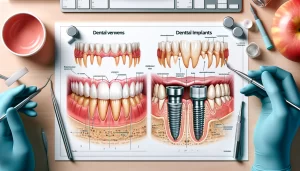Are you wondering how life changes after getting veneers? While the transformation can be remarkable, maintaining that new smile involves understanding the general care required for longevity and oral health. It’s about embracing a routine that supports the durability and appearance of your veneers without delving into specifics or personal recommendations.
Dental Veneers vs. Implants: Understanding the Difference

Exploring the Differences: Conyers Dental Veneers vs. Implants – A visual guide to understanding the distinct processes and benefits of each dental treatment option.
When considering cosmetic dentistry, it’s essential to understand the key differences between veneers and implants, as they cater to different dental needs and maintenance routines. Veneers are thin shells designed to cover the front surface of teeth, enhancing their appearance by altering their color, shape, size, or length. They are typically made from porcelain or composite resin and are bonded to your existing teeth. On the other hand, dental implants are a more invasive procedure that replaces the entire tooth structure, from root to crown. Implants involve inserting a titanium post into the jawbone, which serves as a sturdy foundation for a replacement tooth or bridge.
While veneers are an excellent option for those looking to improve the aesthetics of their smile without extensive dental work, they do require some specific care to maintain their appearance and longevity. It’s important to note that veneers are not a one-size-fits-all solution, and there are different types available, including those that are removable. For a deeper understanding of your options, consider exploring “Are Dental Veneers Removable? Understanding Permanent vs. Temporary Options.” Implants, however, are a permanent solution for lost teeth and can last a lifetime with proper care, including regular brushing, flossing, and dental check-ups. Both treatments can dramatically improve your smile and quality of life but require different levels of commitment and care.
The Durability of Dental Veneers

Unveiling the Strength: The Durability of Conyers Dental Veneers – Discover how these advanced dental solutions offer lasting beauty and functionality.
When discussing the longevity and resilience of dental veneers, it’s important to address the misconception that they are not durable. In reality, veneers are crafted from high-quality materials such as porcelain or composite resin, which are both known for their strength and ability to withstand everyday use. While they are not indestructible, with proper care, dental veneers can last for many years. They are bonded to the surface of the teeth with a strong adhesive, which helps to ensure that they remain in place through daily activities such as eating and speaking.
The lifespan of dental veneers often depends on how they are maintained, as well as the habits and oral hygiene of the individual. It’s crucial to understand that while veneers are robust, they should be treated with the same care as natural teeth to preserve their appearance and function over time. For those considering this dental solution, it’s advisable to consult with a professional for personalized information. If you’re looking for more detailed insights into the durability and care of dental veneers, consider reaching out to a Conyers Dentist Specializing in Dental Veneers for expert guidance.
Veneers: Cosmetic or Functional Solution?
Veneers have long been associated with the world of cosmetic dentistry, offering individuals the chance to achieve that coveted Hollywood smile with their porcelain or composite materials designed to mimic the natural appearance of teeth. However, beyond their aesthetic appeal, veneers also serve a functional purpose. They can be an integral part of dental restoration, providing a protective layer over damaged or weakened teeth, and can aid in improving a person’s bite and overall oral health. The dual nature of veneers as both a cosmetic and functional solution underscores their versatility in the field of dentistry, catering to a wide range of dental needs and preferences.
The Realism of Modern Veneers
Modern veneers have come a long way in terms of their aesthetic appeal and the realism they offer. Thanks to advancements in dental materials and technology, today’s veneers can closely mimic the natural translucency and texture of real teeth. They are crafted with such precision that it becomes nearly impossible to distinguish them from a patient’s natural dentition. The color can be matched perfectly to surrounding teeth, ensuring a seamless integration into one’s smile. This level of realism not only enhances the visual appeal but also contributes to the confidence and comfort of those who choose veneers for their cosmetic dental needs.
For those interested in exploring their options for a brighter smile, Conyers Dental Associates can provide further information on modern dental solutions.
Caring for Teeth with Veneers
Living with veneers involves understanding the importance of maintaining your dental health. Veneers, while durable and aesthetically pleasing, require a certain level of attention to ensure their longevity and the continued health of your natural teeth. Regular dental check-ups are essential, as they allow professionals to monitor the condition of your veneers and the underlying teeth. Good oral hygiene practices are also crucial, as they help to prevent issues that could compromise the integrity of your veneers. It’s important to be aware of how daily habits can affect your dental veneers and to stay informed about general care guidelines to maintain the appearance and function of your enhanced smile.
Conclusion
For any inquiries, feel free to reach out at 770-483-6655 or read what others have to say on Google Maps.

